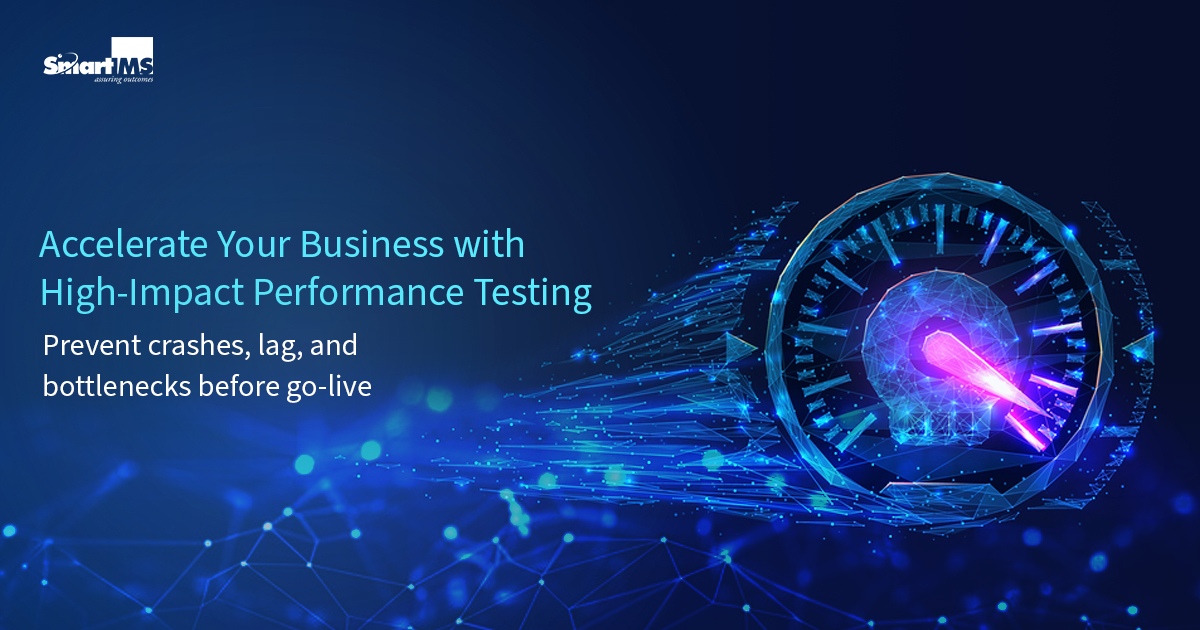Let’s set the scene: You tap on a food delivery app during the lunch rush or try to snag concert tickets the moment sales go live. But instead of a quick experience, the app freezes, crashes, or throws error messages. For the user, it’s frustrating. For the brand, it’s lost revenue and damaged trust.
In today’s digital world, performance is non-negotiable. Whether it’s an e-commerce flash sale, a high-value financial transaction, or streaming a live cricket match, your system needs to be fast, reliable, and scalable. This is where software performance testing becomes critical. It helps ensure your application thrives under pressure, not breaks.
Before we begin, let’s look at the nitty-gritty details.
What is Performance Testing?
Software performance testing evaluates how well your application performs under a specific workload. It assesses speed, responsiveness, stability, and scalability under real-world conditions. Whether it is a media app, fintech service, or large-scale e-commerce platform, performance testing ensures your system does not break under pressure.
Now, let’s quickly understand the significance.
Why Software Performance Testing Matters?
- Improved User Experience
Faster load times and smooth interactions lead to higher engagement and customer satisfaction. - Higher Conversions and Retention
Users are more likely to stay and complete transactions when the application is responsive and reliable. - Risk Mitigation
Identifies system bottlenecks before they cause downtime during critical events. - Cost Efficiency
Helps optimize resource utilization, leading to reduced infrastructure and maintenance costs.
Now that we’ve explored its importance, let’s quickly dive into some of the biggest challenges teams face during software performance testing.
Key Challenges in Performance Testing
- Replicating Real-World Scenarios: Simulating real-time user behavior at scale can be complex.
- Data Management: Large-scale data setup and cleanup can slow down the testing cycle.
- Tool Integration: Ensuring testing tools integrate seamlessly with CI/CD pipelines.
- Identifying Bottlenecks: Pinpointing exact performance issues requires experience and sophisticated monitoring tools.
Now that we’ve understood the nuances and key challenges, let’s explore the core performance testing methodologies in detail.
7 Best Performance Testing Methodologies You Should Implement
- Load Testing
Load testing checks how a system behaves under expected user loads. It simulates real-world traffic to ensure the application performs reliably when multiple users are active at the same time. This type of testing is essential for platforms that expect high daily user volumes or periodic traffic surges. It helps identify bottlenecks and optimize performance before users are affected.
Example: Flipkart during Big Billion Days Sale
Flipkart’s Big Billion Days sale attracts millions of customers looking for discounts on various products. The site sees massive traffic spikes during this period. Load testing helps ensure that Flipkart can handle this expected traffic without crashing or slowing down.
- Goal: Test the system’s ability to handle thousands or even millions of users browsing, adding items to carts, and checking out simultaneously.
- Metrics: Response time (how fast product pages load), throughput (how many product searches and purchases can the system process per second), and error rate (any failures, like users unable to add items to the cart or complete purchases).
- Stress Testing
Stress testing evaluates how a system reacts when pushed beyond its normal capacity. The idea is to identify the breaking point and observe how the system behaves under pressure. This is crucial for understanding recovery time and overall system robustness. It also reveals how well the system fails either gracefully or catastrophically.
Example: Mobile app during new plan launches or festive offers
When telecom operators launch new data plans or limited time offers, their mobile apps often experience huge surges in traffic. Stress testing simulates traffic far beyond the normal load to see how the app handles extreme conditions.
- Goal: Test the app’s stability when traffic exceeds the normal limits (e.g., testing if the app crashes when millions of users simultaneously try to check new plans).
- Metrics: Peak load (number of users before the app crashes), recovery time (how long it takes for the app to become functional again), and error rate (issues like users being unable to log in or complete transactions).
- Spike Testing
Spike testing measures system performance during sudden, extreme increases in load over a short period. Unlike stress testing, the load spikes sharply for a short duration and then drops. This type of testing helps ensure your application doesn’t crash or lag during flash sales or viral promotions.
Example: BookMyShow during movie ticket bookings for blockbuster releases
When a new movie releases, platforms like BookMyShow experience sudden surges in traffic as users rush to book tickets. Spike testing ensures that the website can handle the surge and recover smoothly when the traffic decreases.
- Goal: Simulate sudden, sharp spikes in traffic (e.g., 100,000 users trying to book tickets in a matter of minutes).
- Metrics: System response (how fast the website can handle the traffic spike), recovery time (how quickly the site stabilizes after the spike), and error rate (whether users face issues like slow loading or failures in booking tickets).
- Endurance (Soak) Testing
Endurance testing checks how a system holds up over long periods under continuous load. It’s critical for streaming, live commerce, or gaming apps that are used for extended sessions. This testing helps detect memory leaks, performance degradation, or overheating servers.
Example: Hotstar (Disney+ Hotstar) during live IPL matches
During IPL (Indian Premier League) matches, Hotstar experiences prolonged, continuous traffic from users streaming live cricket matches for several hours. Endurance testing ensures the platform can handle continuous use without degrading performance.
- Goal: Simulate continuous streaming sessions over several hours to ensure there are no performance issues like slow buffering or crashes during a match.
- Metrics: Memory usage (does memory consumption increase over time?), CPU usage (does it cause lagging or high CPU load?), and response time (does the streaming delay increase over time?)
- Volume Testing
Volume testing assesses how a system performs when handling large amounts of data. It focuses more on database performance and backend processing rather than concurrent users. This testing is ideal for fintech, e-commerce, or billing systems with high data volumes.
Example: Paytm during peak transaction hours
During festivals, payment platforms like Paytm experience an increase in transaction volume as people buy gifts, shop online, and make payments for various services. Volume testing helps determine how well Paytm handles these high transaction volumes.
- Goal: Simulate millions of transactions to ensure that the system can handle the load without significant slowdowns or errors.
- Metrics: Throughput (how many transactions the system can process per second), database performance (how fast transactions are processed), and response time (how quickly users can complete payments).
- Configuration Testing
Configuration testing evaluates how the application behaves across different environments, networks, and hardware. This is critical during cloud migrations or software upgrades. It ensures the application performs consistently regardless of server location, operating system, or environment-specific constraints.
Example: Zomato or Swiggy during server upgrades
When food delivery services like Zomato or Swiggy migrate their app to a new cloud environment (e.g., shifting from one cloud provider to another, such as AWS to Azure), configuration testing ensures the system performs well in the new environment.
- Goal: Test the performance of the app across different server environments or network setups (e.g., testing how well the system performs in AWS vs. GCP vs. on-prem servers).
- Metrics: Response time (does the app respond slower with certain configurations?), resource utilization (does the system use more CPU/RAM with different setups?), and system stability (does the app crash or have errors in specific configurations?).
- Scalability Testing
Scalability testing verifies how efficiently an application can scale when demand increases. This could mean increasing users, data size, or transaction volumes. The test checks whether system resources can be added (like more servers or threads) without affecting performance.
Example: Ride-hailing apps during festive seasons or city-specific events (e.g., New Year’s Eve)
Cab aggregators need to ensure that their app can handle a massive surge in demand during high-traffic times, such as New Year’s Eve or when popular events like concerts or cricket matches take place.
- Goal: Test if the app can scale by adding more drivers, processing more ride requests, and handling increased traffic without degrading user experience.
- Metrics: Throughput (how many ride requests the system can process per second), response time (how quickly the system matches riders with drivers), and resource utilization (how much CPU/RAM is needed as the system scales).
Let’s take a look at some of the tools businesses use for performance testing services.
Key Tools Used During Performance Testing:
- JMeter and Gatling: Popular for load and performance testing across various industries in India.
- LoadRunner and BlazeMeter: Often used by large enterprises like banks and e-commerce platforms for robust testing.
- Grafana and Prometheus: Frequently used for endurance and scalability testing to monitor system performance over time.
How Smart IMS Helps You Stay Performance-Ready?
In industries where milliseconds matter and downtime costs millions, Smart IMS delivers precision-engineered performance testing. Whether you’re in e-commerce, fintech, or managing complex ERP systems, our performance engineering services are built to keep you scale-ready.
Here’s what Smart IMS brings to the table:
- End-to-End Performance Testing: From front-end load times to back-end processing, we test every layer to ensure consistent performance across your tech stack.
- Load and Stress Testing: Simulate real-world and peak traffic scenarios to identify bottlenecks before they impact users.
- Root Cause Analysis: Quickly isolate performance issues with deep diagnostics and actionable insights.
- Test Automation Integration: Build performance testing into your CI/CD pipeline for faster, continuous validation.
- Scalability Assessment: Ensure your application architecture can support future growth without compromising performance.
- Performance Tuning: Recommend code-level, configuration, or infrastructure optimizations for faster response and higher throughput.
- Monitoring and Reporting: Get real-time dashboards and detailed reports to track KPIs and performance benchmarks.
Proven Results:
- Crash Rate Reduction: We’ve helped clients reduce application crash rates by up to 40%, ensuring higher uptime during high-load events like flash sales and quarter-end closings.
- Speed Optimization: Our test strategies have cut average response times by 50%, enabling seamless user experiences even under peak traffic—translating directly into increased conversions.
- Retention Gains: With faster load times and greater stability, clients have seen significant increases in user retention, especially during mission-critical usage periods.
Ready to optimize your application’s performance? Connect with Smart IMS today and experience the difference.




